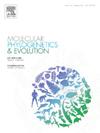Phylogenomic analyses revealed a new lineage of house mouse (Mus musculus) in Gyirong Basin of Xizang Autonomous Region, China
IF 3.6
1区 生物学
Q2 BIOCHEMISTRY & MOLECULAR BIOLOGY
引用次数: 0
Abstract
In the present study, we collected 20 individuals and 12 individuals of wild mice from the Gyirong Basin of Xizang Autonomous Region in China and Sudurpashchim in Nepal. Phylogeny and genetic structure inferred from different types of genomic markers suggest that these samples all belong to Mus musculus, among which individuals from Gyirong Basin represent a new genomic lineage (named as M. m. gyirongus), and samples from Sudurpashchim represent an intermediate population between the central population and M. m. castaneus. M. m. gyirongus, along with M. m. domesticus and M. m. musculus, differentiated from the central population compactly during ∼ 272,000–251,000 years ago in the interglacial period. Three lineages all experienced continuous population decline before ∼ 70,000 years ago. Then, they underwent population fluctuations at different periods that might have been impacted by climate changes, migration history, and human activities. Genes related to the structure and function of neural synapses, reproduction and development, regulation of cell cycle and carcinogenesis, and immune response have undergone positive selection in the genome of M. m. gyirongus. The discovery of M. m. gyirongus not only helps us to better understand the evolutionary history of M. musculus, but also provides new regional resources for breeding novel laboratory mouse strains.

系统基因组学分析揭示了西藏吉荣盆地家鼠(小家鼠)的一个新谱系
本研究在中国西藏吉荣盆地和尼泊尔苏杜尔帕什钦采集了20只野生小鼠和12只野生小鼠。根据不同类型的基因组标记推断的系统发育和遗传结构表明,这些样本都属于小家鼠,其中吉荣盆地的个体代表了一个新的基因组谱系(命名为M. M. gyirongus), Sudurpashchim的样本代表了一个介于中心种群和M. M. castaneus之间的中间种群。m.m. gyirongus与m.m. domesticus和m.m. musculus在距今27.2万至25.1万年前的间冰期与中心种群发生了紧密分化。在大约7万年前,三个谱系都经历了人口的持续下降。然后,它们在不同时期经历了可能受到气候变化、迁徙历史和人类活动影响的人口波动。在gyirongus基因组中,与神经突触结构和功能、生殖发育、细胞周期和癌变调控以及免疫应答相关的基因经历了正选择。gyirongus的发现不仅有助于我们更好地了解M. musculus的进化史,而且为培育新的实验室小鼠品系提供了新的区域资源。
本文章由计算机程序翻译,如有差异,请以英文原文为准。
求助全文
约1分钟内获得全文
求助全文
来源期刊
CiteScore
7.50
自引率
7.30%
发文量
249
审稿时长
7.5 months
期刊介绍:
Molecular Phylogenetics and Evolution is dedicated to bringing Darwin''s dream within grasp - to "have fairly true genealogical trees of each great kingdom of Nature." The journal provides a forum for molecular studies that advance our understanding of phylogeny and evolution, further the development of phylogenetically more accurate taxonomic classifications, and ultimately bring a unified classification for all the ramifying lines of life. Phylogeographic studies will be considered for publication if they offer EXCEPTIONAL theoretical or empirical advances.

 求助内容:
求助内容: 应助结果提醒方式:
应助结果提醒方式:


